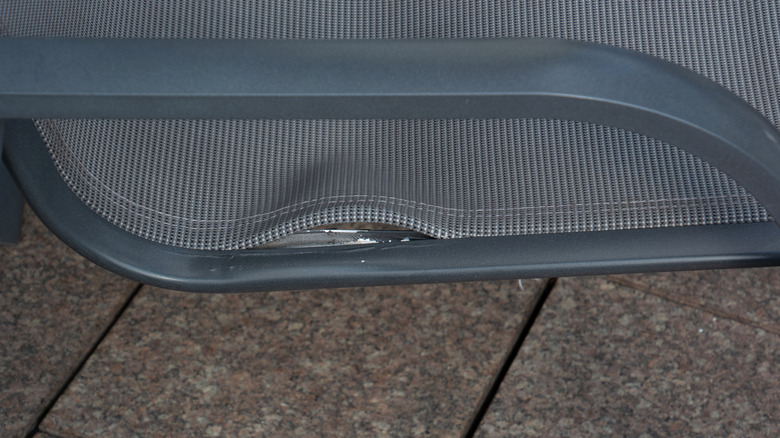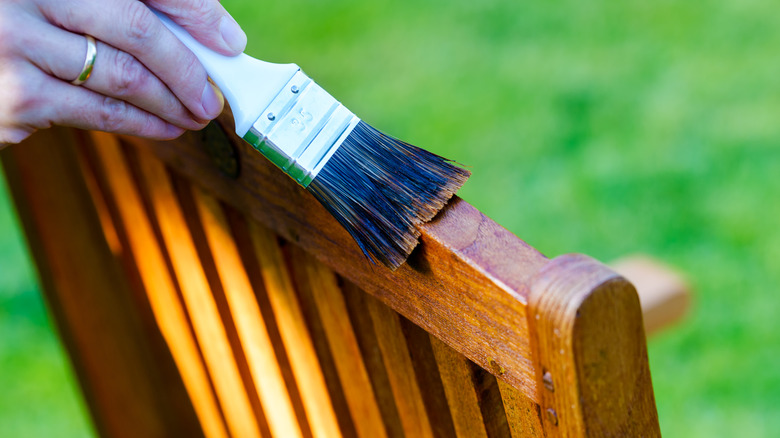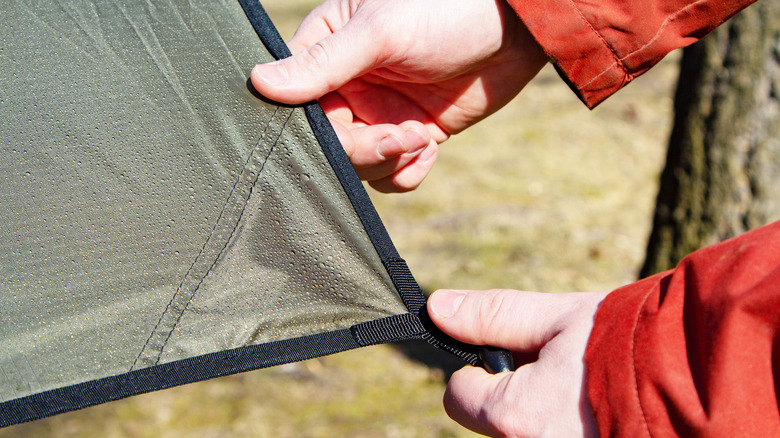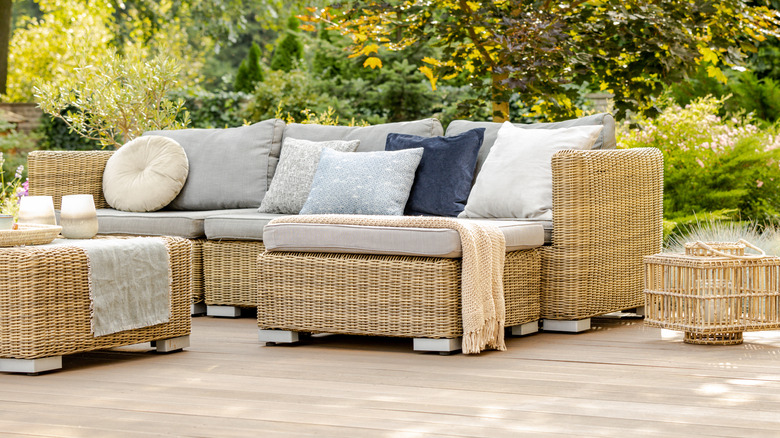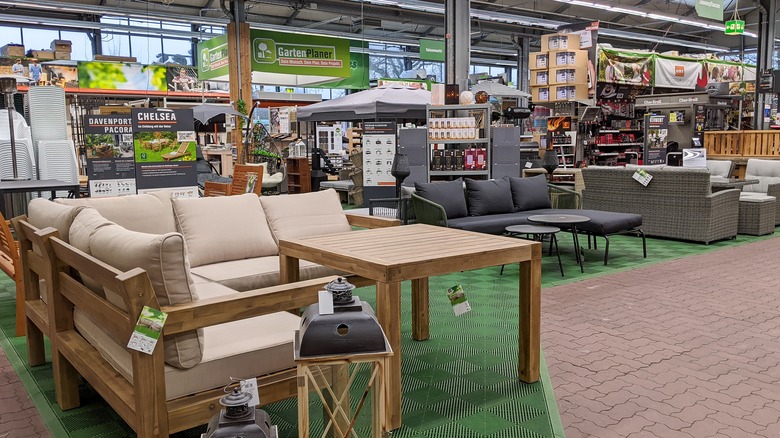A Cleaning Expert Tells Us The Best Ways To Clean And Prepare Outdoor Furniture For Winter Storage
When the warm season comes to a close, it's not uncommon for people to pack up the patio furniture and other items they've used all summer long to protect them from winter weather. Doing so could help preserve the value of these pieces and, considering the average cost of patio furniture ranges from $200 to $5,000 (via Fixr), that's a big investment worthy of preservation.
In an exclusive interview with House Digest, Simon Barker, co-founder and editor at Grow Your Yard, shares some insights into the best ways to clean and prepare outdoor cushions for the winter months. "An essential part of preparing your garden for the fall is ensuring your expensive garden furniture is weatherproof, which isn't always as straightforward as it might seem." He continues, "Giving your garden furniture a new coat of paint or varnish is an obvious place to start, but there are other things you can do to protect your furniture and keep it looking its best."
Repair wear and tear
Summer brings with it lots of time to entertain and spend time using that furniture, from bonfires to having guests over for a nice dinner party under the stars. Using your furniture is the obvious goal, but it also creates a risk of damage. Simon Barker shares, "Before you start weatherproofing your garden furniture, it's essential to check for any signs of wear and tear. Look for cracks, chips, or flaking paint, and make sure that any moving parts are still in good working order."
A thorough visual inspection of all components (including the undersides) of your furniture will shed light on what work needs to be done. Barker advises, "If you spot any problems, make sure you repair them before you start weatherproofing, as this will help extend your furniture's life." Sometimes the manufacturer will offer replacement components you can look up using the model number. Otherwise, you may be able to find adhesives and furniture repair materials online or at a home improvement store.
Apply a coat of paint or varnish
Now that the furniture is in good overall condition, it's possible to seal off winter weather to protect it from damage. After checking for any manufacturer restrictions or recommendations on this process, especially if you have a warranty in place, Simon Barker offers some key suggestions. "One of the easiest ways to weatherproof your garden furniture is to give it a new coat of paint or varnish. This will help to protect it from the elements and keep it looking its best."
It doesn't have to take long to complete this process, but it should be done properly. "Make sure you use a good quality paint or varnish designed explicitly for outdoor use and apply a few coats for some added protection," recommends Barker. Take your time with it, ensuring proper coverage of the furniture to minimize any risks. Again you'll find the materials you need at a home improvement store, including the varnish or paint and brushes. Be sure to check the product manufacturer's recommendations for use as well.
Use tarps for protection
What if you're unable to paint or varnish your furniture because of the material it is made of or constraints on your time? Simon Barker shares, "If you haven't got the time to varnish your furniture, one of the best things you can do is invest in some tarps. Heavy-duty tarps are great for protecting garden furniture from bad weather and are relatively inexpensive." Be sure to purchase waterproof tarps large enough to fully cover your furniture, especially if you don't plan to move it to a sheltered location.
"Don't forget to secure the tarps with bungee cords; you'll thank me on those inevitable windy days," warns Barker. Many tarps have metal grommets along the edges that allow you to thread a rope through it. Use the grommets to help wrap the furniture tightly in the tarp. You can also fold the edges under the legs of the furniture to protect the actual bottoms from extreme winter damage.
Store your furniture in a shed or garage
If you've invested in an expensive piece of furniture, a nice fire pit, and perhaps even some customized cushions for a lounge, you certainly want to take more aggressive steps at protecting each item. Simon Barker offers a solution to this. "If you're not going to use your garden furniture during the winter and have the space, put it into storage." That could be in the garage, a storage shed, or any other location that will stay dry.
Is it really worth doing this if you have to lug heavy items from your backyard deck into the garage? Barker says, "Even with the best weatherproofing tactics, your garden furniture will eventually succumb to the elements; the most effective way to combat this is to store it in a safe, dry environment, ready for next year." Be sure to move it carefully and avoid dropping items. Try to cover up cushions with a cloth or plastic to minimize the amount of dust that can build up on them, especially if you use the garage for your vehicle storage.
Shop for weather-resistant materials
Even when you've done your best, there may be times when replacing your furniture is necessary. If that's the case, make the best choice possible with your next purchase. "You can get a head start on weatherproofing by buying furniture more resistant to poor weather conditions," suggests Simon Barker. Shop with care and compare a few products. "When looking for garden furniture, always go for hardwoods with a high oil content; hardwood is a robust and durable material, and the high oil content is naturally water and rot-resistant," he adds.
Not everyone wants a wood look, so there are other options to consider. "Alternatively, you could look for furniture that's made from aluminum or stainless steel, both of which are rust-resistant," Barker explains. Buying the perfect outdoor furniture means finding something you love. There are lots of weatherproof products, especially higher grade, that are specifically designed for tough climates and yet remain stylish and trendy.

